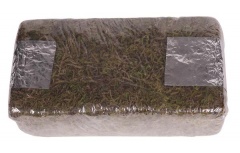Peat
| Infobox on Peat | |
|---|---|
| Example of Peat |  |
| Facts | |
| Origin | - |
| Stowage factor (in m3/t) | 5,7 m3/t (bales of 48 kg.) |
| Humidity / moisture | - |
| Ventilation | - |
| Risk factors | See text |
Peat
Contents
Description
Peat (turf) is an accumulation of partially decayed vegetation. One of the most common components is Sphagnum moss, although many other plants can contribute. Soils that contain mostly peat are known as a histosol. Peat forms in wetland conditions, where flooding obstructs flows of oxygen from the atmosphere, slowing rates of decomposition.
Mires, particularly bogs, are the most important source of peat, but other less common wetland types also deposit peat, including fens, pocosins, and peat swamp forests. Other words for lands dominated by peat include moors, or muskegs. Landscapes covered in peat also have specific kinds of plants, particularly Sphagnum moss, Ericaceous shrubs, and sedges (see bog for more information on this aspect of peat). Since organic matter accumulates over thousands of years, peat deposits also provide records of past vegetation and climates stored in plant remains, particularly pollen. Hence they allow humans to reconstruct past environments and changes in human land use.
Peat is harvested as an important source of fuel in certain parts of the world. By volume, there are about 4 trillion m³ of peat in the world covering a total of around 2% of global land area (about 3 million km²), containing about 8 billion terajoules of energy. Over time, the formation of peat is often the first step in the geological formation of other fossil fuels such as coal, particularly low grade coal such as lignite.
Depending on the agency, peat is not generally regarded as a renewable source of energy, due to its extraction rate in industrialized countries far exceeding its slow regrowth rate of 1mm per year, and as it is also reported that peat regrowth takes place only in 30-40% of peatlands. Because of this, the UNFCCC, and another organization affiliated with the United Nations classified peat as a fossil fuel. However, the Intergovernmental Panel on Climate Change (IPCC) has begun to classify peat as a "slow-renewable" fuel. This is also the classification used by many in the peat industry.
At 106 g CO2/MJ, the carbon dioxide emission intensity of peat is higher than that of coal (at 94.6 g CO2/MJ) and natural gas (at 56.1) (IPCC). Under the appropriate circumstances, peat could be considered an early component in the formation of coal.
Peat has a high carbon content and can burn under low moisture conditions. Once ignited by the presence of a heat source (e.g., a wildfire penetrating the subsurface), it smoulders. These smouldering fires can burn undetected for very long periods of time (months, years, and even centuries) propagating in a creeping fashion through the underground peat layer. Peat fires are emerging as a global threat with significant economic, social, and ecological impacts. Recent burning of peat bogs in Indonesia, with their large and deep growths containing more than 50 billion tons of carbon, has contributed to increases in world carbon dioxide levels.
Peat occurs in surface layers of 3-10 ft thick and has a water content of 85%. Before peat can be used for chemical or fuel purposes it must be field-dried to a water content of 30-40%. Since the dried product is susceptible to autoignition, storage conditions must be such as to minimize this risk.











